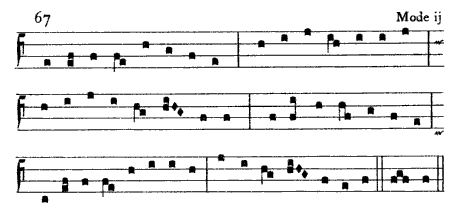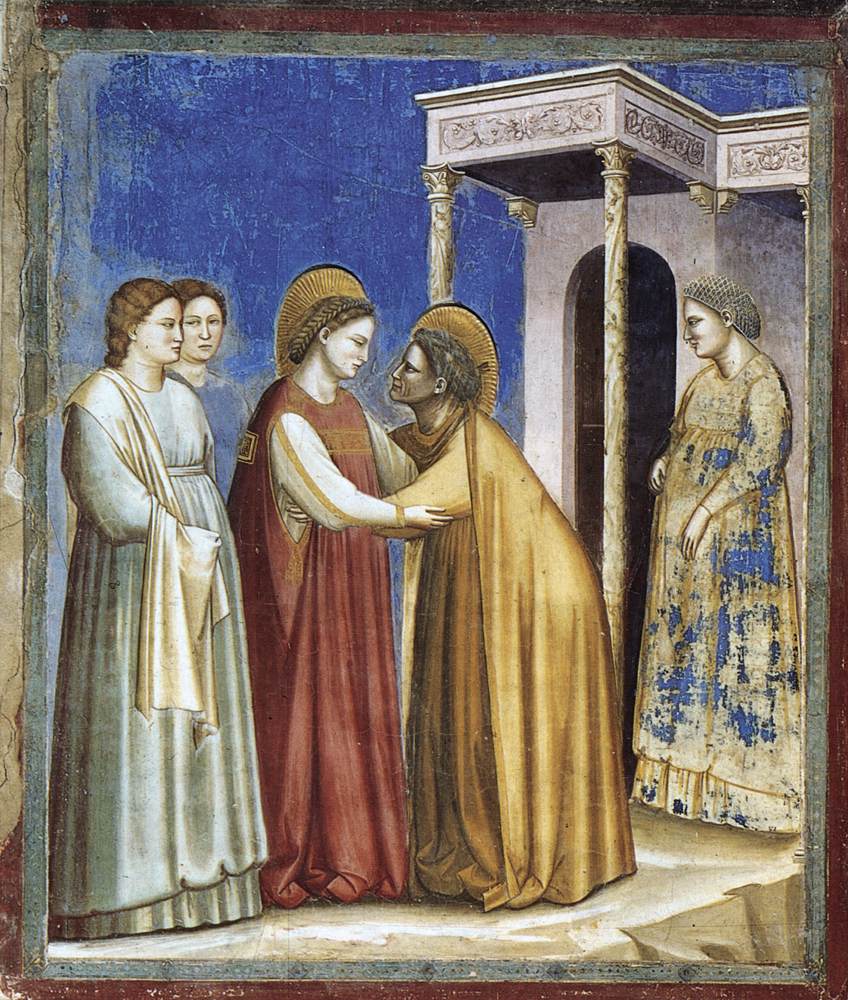From Hymn melodies for the whole year from the Sarum Service-books:
As you can see, this feast was once celebrated on July 2; Wikipedia says this:
And the May 31 date does make more sense. According to New Advent, "Assuming that the Annunciation and the Incarnation took place about the vernal equinox, Mary left Nazareth at the end of March and went over the mountains to Hebron, south of Jerusalem, to wait upon her cousin Elizabeth....")
You can follow along with the Offices on the day at Breviary Offices, from Lauds to Compline Inclusive (Society of St. Margaret, Boston, 1885)); this listing is for its old date, July 2 I'll link-in via iFrame to the SSM book at the bottom of the post too.
Unfortunately, I don't have sound files for any of these hymns, but all three of them use melodies found at other feasts (see those sound files below). Following is the lowdown.
For Vespers, it's Festum matris gloriose, which LLPB's book of hymn names lists as "Now in the holy celebration," and which is in the Hymner, translated, at this page. This is the same melody as Tibi Christe, splendor patri, the Vespers hymn for The Feast of St. Michael and All Angels. Here's G. Vianini's version of that hymn, so you can have the tune:
Here is the chant score:

Oremus hymnal offers these words for a hymn of that name:
For Mattins, the hymn is Mundi salus affutura - "Portal of the world's salvation." Here's a midi of the plainsong; iinterestingly, it's the same tune as is used for Urbs beata Ierusalem and Angulare fundamentum, the two office hymns used on the Feast of the Dedication of a Church. (This in a way makes sense, since Mary herself is Mater Ecclesia.) This uses the same tune as the Transfiguration hymn, English translation in the Hymner here, and here's the chant score:

Oremus has words for this one, too:
For Lauds: O salutaris. This is not the famous "O Salutaris Hostia" but rather O salutaris fulgens stella maris. It apparently comes from the Paris Breviary; I found, in this issue of The Dublin Review at Google Books, this entry about this hymn:
This melody is also used at Purification for another hymn, and at a couple of the other Marian feasts. The tune is the same one Hymn melodies gives for Iste Confessor (as here for the Feast Day of Martin of Tours); the tune is the one on this mp3, from the Lutheran Liturgical Prayer Brotherhood. (The words sung on that sound file are those of Iste Confessor, not O Salutaris.) The same melody is used at the Feast of the Transfiguration for the Mattins hymn O Sator Rerum, for the St. John the Baptist Vespers hymn Ut queant laxis, and at numerous other offices at various times.
Here are the Latin words from above:
O salutaris fulgens stella maris
generans prolem veritatis solem
mater bonorum clemens famulorum
suscipe votum.
Congratulamur et tuas conaraur
canere laudes que deo congaudes
sed non condignis prevalemus ympnis
dicere totum.
Quam veterana traxit in montana
gressu festina rosa matutina
tibi jubilamus concelebramus
hec tua festa.
Vocem rachelis exaudi de celis
que te nunc orat filiosque plorat
potens regina gratia divina
pellere mesta.
O mediatrix orbis reparatrix
laus angelorum salus infirmorum
spes feminarum hostem animarum
reprime sevum.
Sit benedicta trinitas invicta
per quam beata virgo coronata
meruit frui fructus ventris sui
nunc et in evum. Amen.
(I'm starting to recognize most of these words at this point; perhaps one day I'll be able to dash off an English translation on the spot. I'm not sure today's the day - but it'll be soon, I think!)
Here's the chant score:
And here's the SSM Breviary peek-in, as promised:
On the Feast of the Visitation of the B. V. Mary (July 2) & during the 8ve (when the Service is of the Feast) :
Evensong: Festum matris gloriose ... ... ... 67
Mattins: Mundi salus affutura ... ... ... 45
Lauds: O salutaris ... ... ... ... 56
As you can see, this feast was once celebrated on July 2; Wikipedia says this:
This feast is of medieval origin. It was kept by the Franciscan Order before 1263 when St. Bonaventure recommended it, and the Francisian chapter adopted it. The Franciscan breviary spread it to many churches, but it was only universally adopted in 1389, when Pope Urban VI extended it for the whole Church, to be celebrated on 2 July, a date that was kept in the Tridentine Calendar. In 1969, Pope Paul VI moved the celebration to 31 May, between the solemnity of the Annunciation of the Lord and that of the Nativity of St. John the Baptist, "so that it would harmonize better with the Gospel story".[1] In the Anglican Common Worship, the date of 31 May is adopted, although the 1662 Book of Common Prayer has the 2 July date.
And the May 31 date does make more sense. According to New Advent, "Assuming that the Annunciation and the Incarnation took place about the vernal equinox, Mary left Nazareth at the end of March and went over the mountains to Hebron, south of Jerusalem, to wait upon her cousin Elizabeth....")
You can follow along with the Offices on the day at Breviary Offices, from Lauds to Compline Inclusive (Society of St. Margaret, Boston, 1885)); this listing is for its old date, July 2 I'll link-in via iFrame to the SSM book at the bottom of the post too.
Unfortunately, I don't have sound files for any of these hymns, but all three of them use melodies found at other feasts (see those sound files below). Following is the lowdown.
For Vespers, it's Festum matris gloriose, which LLPB's book of hymn names lists as "Now in the holy celebration," and which is in the Hymner, translated, at this page. This is the same melody as Tibi Christe, splendor patri, the Vespers hymn for The Feast of St. Michael and All Angels. Here's G. Vianini's version of that hymn, so you can have the tune:
Here is the chant score:

Oremus hymnal offers these words for a hymn of that name:
Now in holy celebration
sing we of that Mother blest,
in whose flesh for men's salvation
God incarnate deigned to rest,
when a kindred salutation
named in faith the mystic Guest.
Lo, the advent Word confessing,
spake for joy the voice yet dumb,
through his mother's lips addressing
her, of motherhood the sum,--
bower of beauty, blest and blessing,
crowned with fruit of life to come.
"Whence," she cried, at that fair meeting,
"comes to me this great reward?
For when I first heard the greeting
of the Mother of my Lord,
in my womb, the joy repeating,
leapt my babe in sweet accord!"
Lo, at that glad commendation
joy found voice, in Mary's breast
while in holy exultation
she her Maker's power confessed,
at whose word each generation
now henceforward names her blest.
Triune Godhead, health supplying,
Ruler of eternity,
on the fount of grace relying,
we uplift our hearts to thee,
praying that in realms undying
we at one with Life may be.
For Mattins, the hymn is Mundi salus affutura - "Portal of the world's salvation." Here's a midi of the plainsong; iinterestingly, it's the same tune as is used for Urbs beata Ierusalem and Angulare fundamentum, the two office hymns used on the Feast of the Dedication of a Church. (This in a way makes sense, since Mary herself is Mater Ecclesia.) This uses the same tune as the Transfiguration hymn, English translation in the Hymner here, and here's the chant score:

Oremus has words for this one, too:
Portal of the world's salvation,
lo, a Virgin pure and mild,
humble-hearted, high in station,
form of beauty undefiled,
crown of earth's anticipation,
comes the Mother-maid with child.
Here the serpent's power subduing,
see the bush unburned by fire,
Gideon's fleece of heaven's imbuing,
Aaron's rod of bright attire,
fair, and pure, and peace-ensuing,
spouse of Solomon's desire.
Jesse's branch received its flower,
Mother of Emmanuel,
portal sealed and mystic bower
promised by Ezekiel,
rock of Daniel's dream, whose power
smote, and lo, the image fell!
See in flesh so great a wonder
by the power of God ordained,--
him, whose feet all worlds lay under,
in a Virgin's womb contained;--
so on earth, her bonds to sunder,
righteousness from heaven hath rained.
Virgin sweet, with love o'erflowing,
to the hills in haste she fares;
on a kindred bestowing
blessing from the joy she bears;
waiting while with mystic showing
time the sacred birth prepares.
What fair joy o'ershone that dwelling,
called so great a guest to greet;
what her joy whose love compelling
found a rest for Mary's feet,
when, the bliss of time foretelling,
lo, the Voice and Word did meet!
God most high, the heaven's foundation,
ruler of eternity;
Jesus, who for man's salvation
came in flesh to make us free;
Spirit, moving all creation,
evermore be praise to thee!
For Lauds: O salutaris. This is not the famous "O Salutaris Hostia" but rather O salutaris fulgens stella maris. It apparently comes from the Paris Breviary; I found, in this issue of The Dublin Review at Google Books, this entry about this hymn:
The hymn at Lauds is written in Sapphic verse, and is, in its way, no leass beautiful than the former. The poet begins by invoking that "bright and guiding ocean star which brought forth the Sun of Righteousness."More at the link. There is a Google book containing the Latin words here, but I've yet to find a complete set of words in English; still looking.
O salutaris fulgens stella maris,
Generans prolem veritatis solem
Mater bonorum clemens famulorum
Suscipe votum.]
This melody is also used at Purification for another hymn, and at a couple of the other Marian feasts. The tune is the same one Hymn melodies gives for Iste Confessor (as here for the Feast Day of Martin of Tours); the tune is the one on this mp3, from the Lutheran Liturgical Prayer Brotherhood. (The words sung on that sound file are those of Iste Confessor, not O Salutaris.) The same melody is used at the Feast of the Transfiguration for the Mattins hymn O Sator Rerum, for the St. John the Baptist Vespers hymn Ut queant laxis, and at numerous other offices at various times.
Here are the Latin words from above:
O salutaris fulgens stella maris
generans prolem veritatis solem
mater bonorum clemens famulorum
suscipe votum.
Congratulamur et tuas conaraur
canere laudes que deo congaudes
sed non condignis prevalemus ympnis
dicere totum.
Quam veterana traxit in montana
gressu festina rosa matutina
tibi jubilamus concelebramus
hec tua festa.
Vocem rachelis exaudi de celis
que te nunc orat filiosque plorat
potens regina gratia divina
pellere mesta.
O mediatrix orbis reparatrix
laus angelorum salus infirmorum
spes feminarum hostem animarum
reprime sevum.
Sit benedicta trinitas invicta
per quam beata virgo coronata
meruit frui fructus ventris sui
nunc et in evum. Amen.
(I'm starting to recognize most of these words at this point; perhaps one day I'll be able to dash off an English translation on the spot. I'm not sure today's the day - but it'll be soon, I think!)
Here's the chant score:
And here's the SSM Breviary peek-in, as promised:












